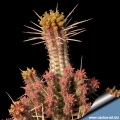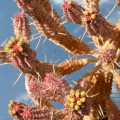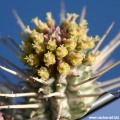Accepted Scientific Name: Euphorbia mammillaris
Sp. Pl. 1: 451. 1753 [1 May 1753]

Euphorbia mammillaris f. variegata Photo by: Valentino Vallicelli
Very popular variegated form with with pale stems stripped in cremy-white and emerald green that turn pink in full sun during the winter .
Origin and Habitat: Garden origin (Nursery produced cultivar)
Synonyms:
See all synonyms of Euphorbia mammillaris
back
Accepted name in llifle Database:Euphorbia mammillaris L.Sp. Pl. 1: 451. 1753 [1 May 1753]Synonymy: 2
back
Description: It is a short stemmed dioecious shrublet producing a dense cluster.
Stem: Thick deep green, erect, simple and ribbed, that in cultivated plants may branch above, 1,5-6 cm in diameter, Mature Height 20-35 cm tall. Usually there are many club-like lateral branches, starting about 10 cm and arches upward.
Ribs: 7-17, with hexagonal crowded tubercles set in vertical rows after the manner of an ear of corn and separated by horizontal grooves.
Spines: Occasionally present and scattered, thick, blunt and whitish, up to 1 cm long. The “spines” are the solitary sterile peduncles.
Leaves: Small, ephemeral.
Flower: It produces yellow solitary cyathia at the tip of each stem. Peduncle ± 2 mm long with several bracts up to 3 mm long. Nectar glands elliptic, separate, yellow-green to purplish.
Blooming season: Late winter to early summer.
Fruits: Obtusely lobed, up to 6 mm in diameter, subsessile.
Seeds: Ovoid, 3x2 mm, smooth.
Forma variegata: The attractive variegated form is easily recognized for its stem which is subtle-cream to frosty greenish-white coloured and splashed with emerald green. In cold temperatures, stems become blushed with delicate rose. Flowers are red and orange.
Subspecies, varieties, forms and cultivars of plants belonging to the Euphorbia mammillaris group
 Euphorbia mammillaris L.: Short stemmed shrublet producing a dense clustered mound. The stems have squarish or hexagonal tubercles in rows resembling "corn cobs"
Euphorbia mammillaris L.: Short stemmed shrublet producing a dense clustered mound. The stems have squarish or hexagonal tubercles in rows resembling "corn cobs" Euphorbia mammillaris f. variegata: Very popular variegated form with with pale stems stripped in cremy-white and emerald green that turn pink in full sun during the winter .
Euphorbia mammillaris f. variegata: Very popular variegated form with with pale stems stripped in cremy-white and emerald green that turn pink in full sun during the winter .
Notes: Variegation, albinism & schizochromism.
Variegation: A variegated plant has sectors, patches or stripes with two or more different colours, even distinct shades of green. Plants with variegated stems or leaves are often attractive and highly prized. In most species the stems or leaves are normally green, and variegated epidermis is an uncommon mutation, termed a chimera. A chimeral variegation is due to losing the ability to produce chlorophyll in some of the plant’s tissue, so that this tissue is no longer green. Tissues lacking chlorophyll are usually white or pale yellow coloured (due to carotenoid pigments) or red (due to betalain or anthocyanin pigments) contrasting with the normal green tissue. There are several forms of variegation, depending on the tissues that have been affected. The variegation in some forms is unstable. The extent and nature of the variegation can vary, and sometimes the plant will return to the green form. In others it is stable and does not change under normal conditions. Because the variegation is due to the presence of two kinds of plant tissue, propagating the plant must be by a vegetative method of propagation that preserves both types of tissue in relation to each other.
Albinism: Every once in a while a plant exhibits albinism (completely lacking chlorophyll pigment). This means that its tissue is unable to carry out photosynthesis. The result is a completely cream-white plant. This plant will be weaker than a green plant, and albinism is generally a fatal trait (it can't produce its own food and it's not getting it from anything else). Without chlorophyll, the albino plant has no way to manufacture the food needed for survival and growth to maturity. This implies that these plants cannot survive on their own roots and necessitate being grafted on a normal green plant that provides food. Some of these albino plants are indeed very popular, and sought after by collectors.
Schizochromism: The yellow or red appearance of some plants is more precisely caused by another aberration called "schizochromism". Here, though, the specific green pigment (chlorophyll) is missing: every other pigment is present at normal levels. The dominant green colouration is lost, but the plant will still more than likely have normal other pigments that give the yellow overall appearance of stems and the red colouration of spines.
Bibliography: Major references and further lectures
1) Urs Eggli “Illustrated Handbook of Succulent Plants: Dicotyledons” Volume 2. Springer, 2002
 Euphorbia mammillaris f. variegata Photo by: Valentino Vallicelli
Euphorbia mammillaris f. variegata Photo by: Valentino Vallicelli Euphorbia mammillaris f. variegata Photo by: Valentino Vallicelli
Euphorbia mammillaris f. variegata Photo by: Valentino Vallicelli Euphorbia mammillaris f. variegata Photo by: Valentino Vallicelli
Euphorbia mammillaris f. variegata Photo by: Valentino Vallicelli Euphorbia mammillaris f. variegata Photo by: Valentino Vallicelli
Euphorbia mammillaris f. variegata Photo by: Valentino Vallicelli Euphorbia mammillaris f. variegata Photo by: Cactus Art
Euphorbia mammillaris f. variegata Photo by: Cactus Art Euphorbia mammillaris f. variegata Photo by: Valentino Vallicelli
Euphorbia mammillaris f. variegata Photo by: Valentino Vallicelli Euphorbia mammillaris f. variegata Photo by: Valentino Vallicelli
Euphorbia mammillaris f. variegata Photo by: Valentino Vallicelli Euphorbia mammillaris f. variegata Photo by: Valentino Vallicelli
Euphorbia mammillaris f. variegata Photo by: Valentino VallicelliCultivation and Propagation: Euphorbia mammillaris f. variegata is an easy to grow ornamental species suited for any well drained soil in half or full sun.
Growth rate: It is a relatively fast growing species, but it it possible to increase the speed of growth to some extent by providing adequate amount of water, warmth, and fertilizer during the active growing season, but it’s susceptible to rotting if too wet and do not like a lot of water when it is on rest.
Soil and pots: It likes pots with generous drain holes, needs a very airy potting medium which mainly consists of non organic material such us clay, pumice, lava grit, and only a little peat or leaf-mould,
Fertilization: Need a perfect fertilizer diet in summer. Use preferably a cacti and succulents fertilizer with high potassium content including all micro nutrients and trace elements or slow release fertilizer.
Exposure: This plant has an good heat tolerance, and need light shade exposures, it grows well even in full sun, but tolerate moderate shade, and a plant that has been growing in shade should be slowly hardened off before placing it in full sun as the plant will be severely scorched if moved too suddenly from shade into sun. The colour of this plant is much more marked if grown in full sun.
Watering: Euphorbia mammillaris f. variegata is an opportunistic grower, water regularly when it is growing. No water should ever be allowed to stand around the roots. Keep almost completely dry in winter. However this spurge will tolerate dryness and can even thrives in poor, dry soils, but do better when grown in nutrient-rich soils with regular watering.
Hardiness: Tender. This spurge cannot tolerate any frost and can be difficult to get it to look its best without a good amount of heat and sun and so it is only really suited to the tropics. It can be grown outdoors in frost-free climates.
Rot: Rot it is only a minor problem with Euphorbias if the plants are watered and “aired” correctly. If they are not, fungicides won't help all that much.
Maintenance: Re-pot every two years and trim off the dead 'arms'.
Known hazards: The latex/sap is poisonous and can cause skin rash, itching and general discomfort, and they should be handled with caution, particularly when pruning.
Propagation: The plant can be reproduced by seeds or cuttings. The plant may be propagated by branch cuttings. If you remove an offset, remember to let it dry for some days, letting the wound heal (cuttings planted too soon easily rot before they can grow roots). Lay it on the soil and insert the stem end partially into the substrate. Try to keep the cutting somewhat upright so that the roots are able to grow downward. It is better to wash the cut to remove the latex.
Your Photos

by Cactus Art

by Valentino Vallicelli

by Cactus Art





















